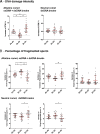Determination of double- and single-stranded DNA breaks in bovine sperm is predictive of their fertilizing capacity
- PMID: 36114517
- PMCID: PMC9482281
- DOI: 10.1186/s40104-022-00754-8
Determination of double- and single-stranded DNA breaks in bovine sperm is predictive of their fertilizing capacity
Abstract
Background: The analysis of chromatin integrity has become an important determinant of sperm quality. In frozen-thawed bovine sperm, neither the sequence of post-thaw injury events nor the dynamics of different types of sperm DNA breaks are well understood. The aim of the present work was to describe such sperm degradation aftermath focusing on DNA damage dynamics, and to assess if this parameter can predict pregnancy rates in cattle.
Results: A total of 75 cryopreserved ejaculates from 25 Holstein bulls were evaluated at two post-thawing periods (0-2 h and 2-4 h), analyzing global and double-stranded DNA damage through alkaline and neutral Comet assays, chromatin deprotamination and decondensation, sperm motility, viability, acrosomal status, and intracellular levels of total ROS, superoxides and calcium. Insemination of 59,605 females was conducted using sperm from the same bulls, thus obtaining the non-return to estrus rates after 90 d (NRR). Results showed an increased rate of double-stranded breaks in the first period (0-2 h: 1.29 ± 1.01%/h vs. 2-4 h: 0.13 ± 1.37%/h; P < 0.01), whereas the rate of sperm with moderate + high single-stranded breaks was higher in the second period (0-2 h: 3.52 ± 7.77 %/h vs. 2-4h: 21.06 ± 11.69 %/h; P < 0.0001). Regarding sperm physiology, viability decrease rate was different between the two periods (0-2 h: - 4.49 ± 1.79%/h vs. 2-4 h: - 2.50 ± 3.39%/h; P = 0.032), but the progressive motility decrease rate was constant throughout post-thawing incubation (0-2 h: - 4.70 ± 3.42%/h vs. 2-4 h: - 1.89 ± 2.97%/h; P > 0.05). Finally, whereas no correlations between bull fertility and any dynamic parameter were found, there were correlations between the NRR and the basal percentage of highly-damaged sperm assessed with the alkaline Comet (Rs = - 0.563, P = 0.003), between NRR and basal progressive motility (Rs = 0.511, P = 0.009), and between NRR and sperm with high ROS at 4 h post-thaw (Rs = 0.564, P = 0.003).
Conclusion: The statistically significant correlations found between intracellular ROS, sperm viability, sperm motility, DNA damage and chromatin deprotamination suggested a sequence of events all driven by oxidative stress, where viability and motility would be affected first and sperm chromatin would be altered at a later stage, thus suggesting that bovine sperm should be used for fertilization within 2 h post-thaw. Fertility correlations supported that the assessment of global DNA damage through the Comet assay may help predict bull fertility.
Keywords: Cattle; Chromatin; Comet test; DNA damage; Fertility; Sperm; Sperm quality.
© 2022. The Author(s).
Conflict of interest statement
The authors declare that the research was conducted in the absence of any commercial or financial relationships that could be defined as a potential conflict of interest.
Figures



Similar articles
-
Moribund sperm in frozen-thawed semen, and sperm motion end points post-thaw and post-swim-up, are related to fertility in Holstein AI bulls.Theriogenology. 2012 Mar 15;77(5):940-51. doi: 10.1016/j.theriogenology.2011.09.026. Epub 2011 Dec 3. Theriogenology. 2012. PMID: 22137769
-
Sperm characteristics and zona pellucida binding in relation to field fertility of frozen-thawed semen from dairy AI bulls.Int J Androl. 1998 Aug;21(4):207-16. doi: 10.1046/j.1365-2605.1998.00114.x. Int J Androl. 1998. PMID: 9749351
-
Increasing the frequency of ejaculate collection in young dairy bulls increases semen production and field fertility.Theriogenology. 2022 Apr 1;182:45-52. doi: 10.1016/j.theriogenology.2022.01.030. Epub 2022 Jan 29. Theriogenology. 2022. PMID: 35123310
-
Multicolor flow cytometric analysis of cryopreserved bovine sperm: A tool for the evaluation of bull fertility.J Dairy Sci. 2019 Dec;102(12):11652-11669. doi: 10.3168/jds.2019-16572. Epub 2019 Sep 11. J Dairy Sci. 2019. PMID: 31521361
-
Interpreting sperm DNA damage in a diverse range of mammalian sperm by means of the two-tailed comet assay.Front Genet. 2014 Nov 27;5:404. doi: 10.3389/fgene.2014.00404. eCollection 2014. Front Genet. 2014. PMID: 25505901 Free PMC article. Review.
Cited by
-
Mammalian Species-Specific Resistance to Mammary Cancer.J Mammary Gland Biol Neoplasia. 2025 Mar 6;30(1):3. doi: 10.1007/s10911-025-09578-4. J Mammary Gland Biol Neoplasia. 2025. PMID: 40048007 Free PMC article. Review.
-
Epicatechin Prevents Cryocapacitation of Bovine Spermatozoa through Antioxidant Activity and Stabilization of Transmembrane Ion Channels.Int J Mol Sci. 2023 Jan 28;24(3):2510. doi: 10.3390/ijms24032510. Int J Mol Sci. 2023. PMID: 36768832 Free PMC article.
-
The Effects of Different Doses of ROCK Inhibitor, Antifreeze Protein III, and Boron Added to Semen Extender on Semen Freezeability of Ankara Bucks.Molecules. 2022 Nov 21;27(22):8070. doi: 10.3390/molecules27228070. Molecules. 2022. PMID: 36432171 Free PMC article.
-
Expression of miR-138 in cryopreserved bovine sperm is related to their fertility potential.J Anim Sci Biotechnol. 2023 Sep 20;14(1):129. doi: 10.1186/s40104-023-00909-1. J Anim Sci Biotechnol. 2023. PMID: 37730625 Free PMC article.
-
Impact of Seminal Plasma Antioxidants on DNA Fragmentation and Lipid Peroxidation of Frozen-Thawed Horse Sperm.Antioxidants (Basel). 2024 Mar 6;13(3):322. doi: 10.3390/antiox13030322. Antioxidants (Basel). 2024. PMID: 38539855 Free PMC article.
References
Grants and funding
- P30 GM131944/GM/NIGMS NIH HHS/United States
- Tecniospring Industry TECSPR-19-1-0003/H2020 Marie Skłodowska-Curie Actions
- AGL2017-88329-R and PID2020-113320RB-I00/Ministerio de Ciencia, Innovación y Universidades
- 2017-SGR-1229/Agència de Gestió d'Ajuts Universitaris i de Recerca
- 214/857-202039/Fundació la Marató de TV3
LinkOut - more resources
Full Text Sources

